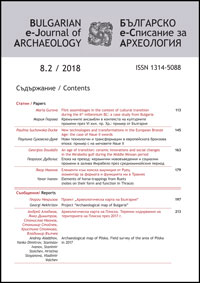Eлементи към конска амуниция от Руец (коментар за формата и функцията им в Тракия)
Elements of horse-trappings from Ruets (notes on their form and function in Thrace)
Author(s): Yavor IvanovSubject(s): History, Archaeology
Published by: Асоциация на българските археолози
Keywords: Archaeology;Ancient Thrace;Classical Period;horse-trappings;burial mounds;
Summary/Abstract: The article discusses three so far unpublished silver cone-shaped elements of horse-trappings found in the tomb near the village of Ruets, Targovishte region.The tomb near the village of Ruets (old Yrukleler), Targovishte region in North-eastern Bulgaria, was discovered by chance in 1925 in the Maljuk mound located in the Kavatsite locality to the southeast of the village. Vasil Mikov excavated the tomb in the same year. According to the available data, a burial was revealed in the tomb, that in turn was under a mound.The grave goods found in the tomb include a bronze Chalcidian type helmet, a bimetal bell cuirass made of bronze and iron, a folding bronze plate (μίτρη) worn together with/under the bell cuirass, an iron short sword – akinakes, two iron spear heads, eleven bronze arrowheads, a bronze amphora-hydria with images of Sirens in the lower parts of the handles, a bronze strainer, a bronze situla, a bronze vessel – podanipter, a bronze buckle, an iron bridle, two bone objects, a glass vessel (aryballos) and a fragment of a red-figured hydria. At present they are stored in the National Archaeological Institute with Museum at the Bulgarian Academy of Sciences, Sofia. Due to the nature of their discovery, it is unclear whether these are all grave goods to the buried warrior. Tree silver cone-shaped elements of horse-trappings are also among the items mentioned above and they are the subject of the present study.
Journal: Българско е-Списание за Археология
- Issue Year: 8/2018
- Issue No: 2
- Page Range: 179-195
- Page Count: 17
- Language: Bulgarian

